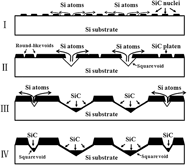Article contents
The surface morphological evolution of ultrathin SiC buffer layer grown on Si (100) substrate by atmospheric pressure chemical vapor deposition
Published online by Cambridge University Press: 09 August 2012
Abstract

Ultrathin SiC buffer layers have been grown on Si (100) substrates by atmospheric pressure chemical vapor deposition. The evolution of buffer layer morphological properties as a function of carbonization parameters is investigated by atomic force microscopy. Based on the quantitative analysis of the dependences of void density, void depth, void width, and surface roughness on carbonization parameters, a buffer layer growth model is proposed, and the effects of carbonization parameters on buffer layer morphology are clarified. The void density is related to the carbonization temperature, temperature ramp-up rate, and C3H8 concentration by affecting the initial SiC nuclei density. The void size is evolved with processing time and mainly dependent on the carbonization temperature but slightly affected by C3H8 and H2. The buffer layer morphology is deteriorated with increasing H2 flow rate when the C3H8 concentration is fixed.
- Type
- Articles
- Information
- Journal of Materials Research , Volume 28 , Issue 1: Focus Issue: Silicon Carbide – Materials, Processing and Devices , 14 January 2013 , pp. 113 - 119
- Copyright
- Copyright © Materials Research Society 2012
References
REFERENCES
- 1
- Cited by


